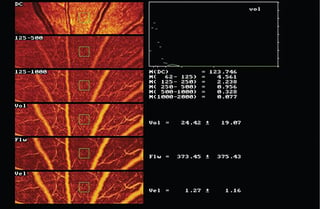Part B: Microvascular Function
Diabetes mellitus is associated with numerous micro- and macrovascular complications. Microvascular dysfunction in patients with diabetes mellitus is a systemic process that occurs in a similar fashion in multiple tissues throughout the body. The investigation of microvascular function can help to identify patients at high risk for the development of micro- but also macrovascular complications. Furthermore, it can provide a quantitative assessment of the effects of a given treatment. Several technologies have been implemented for the assessment of microcirculation in humans. In general it is important to differentiate between morphological changes in small vessels and early functional changes in the microcirculation. For the investigation of microvascular abnormalities, the retina and the skin are predisposed anatomical sites.
Retinal Microcirculation
The diagnosis of diabetic retinopathy is based on the identification of morphological alterations in retinal vessels. The morphology of retinal vessels can be easily assessed by fundoscopy or taking photographs from background of the eye. Early anatomical changes like alterations in vascular wall, venous calibre changes, microaneurysms, retinal haemorrhages usually precede the development of retinal neovascularisations with the transition from non-proliferative to proliferative diabetic retinopathy. A breakdown of the blood retinal barrier leads to extravasation of fluids, lipids and the development of macular oedema. The technology of laser doppler scanning allows for the detection of functional changes in retinal microvascular blood flow [1]. Measuring the hyperaemic response after retinal stimulation with flicker light offers an assessment of retinal neurovascular function [2,3]. The effects of flicker light on retinal capillary blood flow and retinal vascular diameter have repeatedly been suggested to be mediated by nitric oxide (NO) [4]. Retinal capillary blood flow and the hyperaemic response to flicker light was found to be affected in several diseases causing endothelial dysfunction like arterial hypertension, insulin resistance or diabetes mellitus [2,5,6]. Furthermore, an increase in retinal arteriolar wall thickness could be observed in patients with arterial hypertension, stroke and / or metabolic disorders [7-9]. Several drugs like angiotensin receptor blockers, glucagon like peptide 1 receptor agonists, or dipeptidylpeptidase 4 inhibitors were found to improve retinal microvascular function in patients with hypertension or diabetes mellitus [2,10-12].

Skin Microcirculation
Skin microcirculation can be assessed using skin capillaroscopy or laser dopplerfluxmetry. Skin capillaroscopy visualizes capillaries in the nail skin folds by the use of on light microscopy [13]. With this method, capillary morphological alterations y can be identified, and the nutritive capillary blood flow can be measured within single capillaries. The addition of fluorescent dyes enables further assessment of transcapillary diffusion phenomena. The technology of skin capillaroscopy is very complex, and certain technical aspects make it somewhat cumbersome. For this reason, the technology of laser-doppler-fluxmetry is a much more common method for the evaluation of microvascular skin blood flow. Using a laser doppler, blood flow is measured as the flux of red blood cells through both the subpapillary vascular bed and the nutritional capillaries. Lased doppler readings can be done with a doppler probe attached at a single point of the skin or by scanning a certain area of the skin using laser speckle contrast imaging. Even both technologies do not provide any information about morphological changes in skin capillaries; they offer an easy and non-invasive technology for the assessment of early functional changes in skin blood flow. Resting dermal microvascular blood flow is highly variable and underlies a complex regulation including neural and endothelial modifications. The functionality of the skin microvessels to respond to different physiological stimuli is more valuable and reproducible for the assessment of vascular impairment and the evaluation of potential effects of pharmacological intervention. For this reason a couple of microvascular function tests have been implemented testing skin microvascular function. As shown in table 1, these different tests rely on the stimulation of distinct vascular responses. While some address neurovascular reflex arcs, others are mediated by an endothelial response or direct vascular smooth muscle relaxation. Best validated and most often used skin microvascular tests are the heat response, the ischemic hyperaemia, and the iontophoresis of acetylcholine or sodium nitroprusside. The heat response is caused by a vasodilatation following local skin heating to a temperature of 44C°. This acute vasodilatory response is mediated by an axon reflex relying on calcitonin gene related peptide and substance P [14,15]. The post ischaemic microvascular response and the microvascular response to the iontophoresis of acetylcholine is used for the investigation of skin microvascular endothelial function [16]. Acetylcholine causes microcirculatory vasodilatation through two mechanisms. First by a direct binding on muscarinic receptors and the release of nitric oxide from the endothelial cells, and second by the activation of C-nociceptive nerve fibres and an axon reflex mediated vasodilatation. Sodium nitroprusside is a nitric oxide donor that causes endothelium independent, direct vasorelaxation of the vascular smooth muscle, and thereby an increase in skin microvascular blood flow [17].
Stimulus |
Vascular
|
Neural Function |
Endothelial Function
|
|
Venoarteriolar Reflex |
Flow reduction |
X |
|
|
Cold Pressure |
Flow reduction |
X |
|
|
Handgrip |
Flow reduction |
X |
|
|
Deep Inspiration |
Flow Reduction |
X |
|
|
Valsalva Maneuvre |
Flow Reduction |
X |
|
|
Electrical stimulation |
Flow increase |
X |
|
|
Heat response |
Flow increase |
X |
(X) |
|
Iontophoresis of acetylcholine |
Flow increase |
(X) |
X |
|
Iontophoresis of sodium nitroprussid |
Flow increase |
|
X |
|
Ischemia |
Flow increase |
|
X |
Table 1: Tests for the investigation of skin microvascular function with laser-doppler-fluxmetry (modified according to [18])
Reference List
- Kreis A.J., Nguyen T., Rogers S. et al. Reliability of different image analysis methods for scanning laser Doppler flowmetry. Curr Eye Res 2008; 33:493-499.
- Delles C., Michelson G., Harazny J., Oehmer S., Hilgers K.F., Schmieder R.E. Impaired endothelial function of the retinal vasculature in hypertensive patients. Stroke 2004; 35:1289-1293.
- Nguyen T.T., Kawasaki R., Wang J.J. et al. Flicker light-induced retinal vasodilation in diabetes and diabetic retinopathy. Diabetes Care 2009; 32:2075-2080.
- Dorner G.T., Garhofer G., Kiss B. et al. Nitric oxide regulates retinal vascular tone in humans. Am J Physiol Heart Circ Physiol 2003; 285:H631-H636.
- Forst T., Weber M.M., Mitry M. et al. Pilot study for the evaluation of morphological and functional changes in retinal blood flow in patients with insulin resistance and/or type 2 diabetes mellitus. J Diabetes Sci Technol 2012; 6:163-168.
- Garhofer G., Zawinka C., Resch H., Kothy P., Schmetterer L., Dorner G.T. Reduced response of retinal vessel diameters to flicker stimulation in patients with diabetes. Br J Ophthalmol 2004; 88:887-891.
- Rogers S.L., Tikellis G., Cheung N. et al. Retinal arteriolar caliber predicts incident retinopathy: the Australian Diabetes, Obesity and Lifestyle (AusDiab) study. Diabetes Care 2008; 31:761-763.
- Harazny J.M., Ritt M., Baleanu D. et al. Increased wall:lumen ratio of retinal arterioles in male patients with a history of a cerebrovascular event. Hypertension 2007; 50:623-629.
- Forst T., Weber M.M., Mitry M. et al. Retinal Microcirculation in Type 1 Diabetic Patients With and Without Peripheral Sensory Neuropathy. J Diabetes Sci Technol 2014; 8:356-361.
- Berndt-Zipfel C., Michelson G., Dworak M. et al. Vildagliptin in addition to metformin improves retinal blood flow and erythrocyte deformability in patients with type 2 diabetes mellitus -- results from an exploratory study. Cardiovasc Diabetol 2013; 12:59.
- Forst T., Michelson G., Diessel S., Jahnke J., Kapitza C. Microvascular effects of the inhibition of dipeptidylpeptidase IV by linagliptin in nondiabetic hypertensive patients. J Hypertens 2016; 34:345-350.
- Forst T., Michelson G., Ratter F. et al. Addition of liraglutide in patients with Type 2 diabetes well controlled on metformin monotherapy improves several markers of vascular function. Diabet Med 2012; 29:1115-1118.
- Forst T., Kunt T., Pohlmann T. et al. Biological activity of C-peptide on the skin microcirculation in patients with insulin-dependent diabetes mellitus. J Clin Invest 1998; 101:2036-2041.
- Fuchs D., Dupon P.P., Schaap L.A., Draijer R., The association between diabetes and dermal microvascular dysfunction non-invasively assessed by laser Doppler with local thermal hyperemia: a systematic review with meta-analysis. Cardiovasc Diabetol 2017; 16:11.
- Forst T., Caduff A., Talary M. et al. Impact of environmental temperature on skin thickness and microvascular blood flow in subjects with and without diabetes. Diabetes Technol Ther 2006; 8:94-101.
- Forst T., Pfutzner A., Kunt T. et al. Skin microcirculation in patients with type I diabetes with and without neuropathy after neurovascular stimulation. Clin Sci 1998; 94:255-261.
- Abularrage C.J., Sidawy A.N., Aidinian G., Singh N., Weiswasser J.M., Arora S. Evaluation of the microcirculation in vascular disease. J Vasc Surg 2005; 42:574-581.
- Forst T., Pfutzner A. The diagnosis of an autonomic dysfunction of the lower limb as a major aspect of the neurological investigation and risk assessment of a diabetic foot syndrome. MMW Fortschr Med 2004; 146:35-38.




